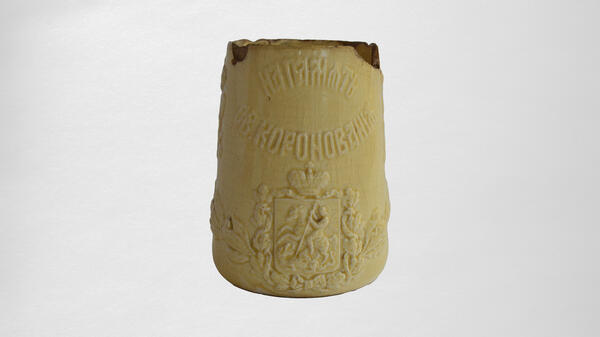The commemorative coronation mug with monograms of the Emperor Nicholas II and his consort, Empress Alexandra Fedorovna, from the museum collection was made in 1896.This exhibit is a reminder not only of the splendid celebrations on the occasion of the coronation of the last Russian emperor and one of the darkest moments in the history of Moscow — the tragedy on the Khodynka Field.
In May 1896, the coronation ceremony of Emperor Nikolai II and his consort, Empress Alexandra Fedorovna, took place in the Assumption Cathedral of the Moscow Kremlin. The coronation of Russian emperors in Moscow was a continuation of the tradition of the coronation of grand dukes and tsars of the Kingdom of Muscovy: only after this ceremony the tsar became a true ruler in the eyes of the people. Therefore, the Romanovs came to be crowned in the first capital, despite the fact that St. Petersburg was then the capital of Russia.
Large-scale preparations for such an event began well in advance. The streets were cleaned up, the old palaces restored, and new ones built. The leading Moscow architects of that time worked on the festive decorations. Along the entire route of their imperial majesties from the Petrovsky Palace to the Kremlin, houses were decorated: they made columns, welcome inscriptions with gilding, monograms, flags, colored fabrics, fringe and greenery.
In 1896, impressive illuminations were prepared in the Kremlin. The celebrations lasted for more than 2 weeks, but were marred by the tragedy on the Khodynka Field. Festive public parties were planned for 18 May, four days after the coronation. Around 400,000 royal gifts were prepared for the people. Each gift was wrapped in a bright souvenir scarf, made by the Prokhorov manufactory. The Kremlin and the Moskva River were depicted on one side, and portraits of the imperial couple on the other. The gift included sweets, sausages, gingerbread and a commemorative mug.
People started arriving at the Khodynka Field on 17 May, and in the morning of 18 May, more than 500,000 visitors gathered in an area of about one square kilometer. A horrible stampede occurred, which took the lives of 1,379 people and crippled about 900 others. One of the reasons for the tragedy was the unfortunate positioning of the stalls where commemorative gifts were handed out.
In May 1896, the coronation ceremony of Emperor Nikolai II and his consort, Empress Alexandra Fedorovna, took place in the Assumption Cathedral of the Moscow Kremlin. The coronation of Russian emperors in Moscow was a continuation of the tradition of the coronation of grand dukes and tsars of the Kingdom of Muscovy: only after this ceremony the tsar became a true ruler in the eyes of the people. Therefore, the Romanovs came to be crowned in the first capital, despite the fact that St. Petersburg was then the capital of Russia.
Large-scale preparations for such an event began well in advance. The streets were cleaned up, the old palaces restored, and new ones built. The leading Moscow architects of that time worked on the festive decorations. Along the entire route of their imperial majesties from the Petrovsky Palace to the Kremlin, houses were decorated: they made columns, welcome inscriptions with gilding, monograms, flags, colored fabrics, fringe and greenery.
In 1896, impressive illuminations were prepared in the Kremlin. The celebrations lasted for more than 2 weeks, but were marred by the tragedy on the Khodynka Field. Festive public parties were planned for 18 May, four days after the coronation. Around 400,000 royal gifts were prepared for the people. Each gift was wrapped in a bright souvenir scarf, made by the Prokhorov manufactory. The Kremlin and the Moskva River were depicted on one side, and portraits of the imperial couple on the other. The gift included sweets, sausages, gingerbread and a commemorative mug.
People started arriving at the Khodynka Field on 17 May, and in the morning of 18 May, more than 500,000 visitors gathered in an area of about one square kilometer. A horrible stampede occurred, which took the lives of 1,379 people and crippled about 900 others. One of the reasons for the tragedy was the unfortunate positioning of the stalls where commemorative gifts were handed out.



